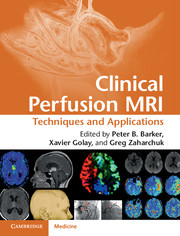Book contents
- Frontmatter
- Contents
- List of Contributors
- Foreword
- Preface
- List of Abbreviations
- Section 1 Techniques
- 1 Imaging of flow: basic principles
- 2 Dynamic susceptibility contrast MRI: acquisition and analysis techniques
- 3 Arterial spin labeling-MRI: acquisition and analysis techniques
- 4 DCE-MRI: acquisition and analysis techniques
- 5 Imaging of brain oxygenation
- 6 Vascular space occupancy (VASO) imaging of cerebral blood volume
- 7 MR perfusion imaging in neuroscience
- Section 2 Clinical applications
- Index
- References
4 - DCE-MRI: acquisition and analysis techniques
from Section 1 - Techniques
Published online by Cambridge University Press: 05 May 2013
- Frontmatter
- Contents
- List of Contributors
- Foreword
- Preface
- List of Abbreviations
- Section 1 Techniques
- 1 Imaging of flow: basic principles
- 2 Dynamic susceptibility contrast MRI: acquisition and analysis techniques
- 3 Arterial spin labeling-MRI: acquisition and analysis techniques
- 4 DCE-MRI: acquisition and analysis techniques
- 5 Imaging of brain oxygenation
- 6 Vascular space occupancy (VASO) imaging of cerebral blood volume
- 7 MR perfusion imaging in neuroscience
- Section 2 Clinical applications
- Index
- References
Summary
Introduction
There are increasing opportunities to use dynamic contrast-enhanced (DCE) T1-weighted imaging to characterize tumor and other pathological biology and treatment response, using modern fast sequences that can provide good temporal and spatial resolution combined with good organ coverage [1]. Quantification in MRI is recognized as an important approach to characterize tissue biology. This chapter provides an introduction to the physical concepts of mathematical modeling, image acquisition, and image analysis needed to measure aspects of tissue biology using DCE imaging, in a way that should be accessible for a research-minded clinician.
Quantification in MRI represents a paradigm shift, a new way of thinking about imaging [2]. In qualitative studies, the scanner is a highly sophisticated camera, collecting images that are viewed by an experienced radiologist. In quantitative studies, the scanner is used as a sophisticated measuring device, a scientific instrument able to measure many properties of each tissue voxel (e.g., T1, T2, diffusion tensor,magnetization transfer, metabolite concentration, Ktrans). An everyday example of quantification would be the bathroom scales, used to measure our weight. We expect that the machine output shown on the dial, in kg, will be accurate (i.e., close to the true value), reproducible (i.e., if we make repeated measurements over a short time they will not vary), reliable (the scales always work), and biologically relevant (the quantity of weight does indeed relate to our health). An example of a clinical measurement would be a blood test; we expect it to work reliably every time. This is the aspiration for quantitative MRI: that it should deliver a high-quality measurement that relates only to the patient biology (and not the state of the scanner at the time of measurement).
- Type
- Chapter
- Information
- Clinical Perfusion MRITechniques and Applications, pp. 58 - 74Publisher: Cambridge University PressPrint publication year: 2013
References
- 14
- Cited by

